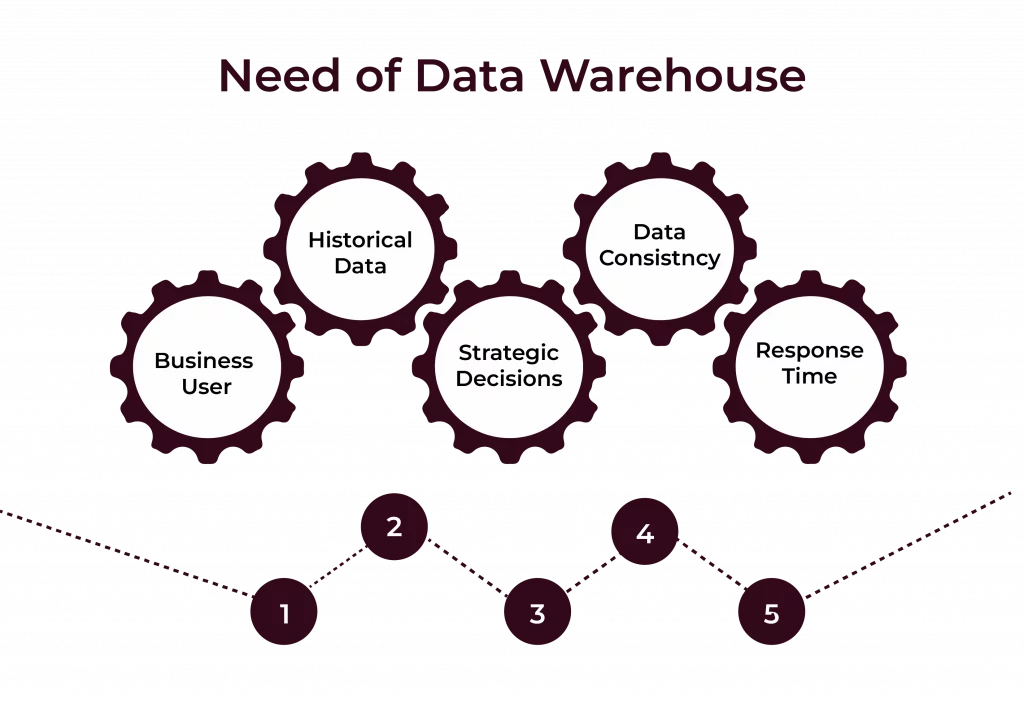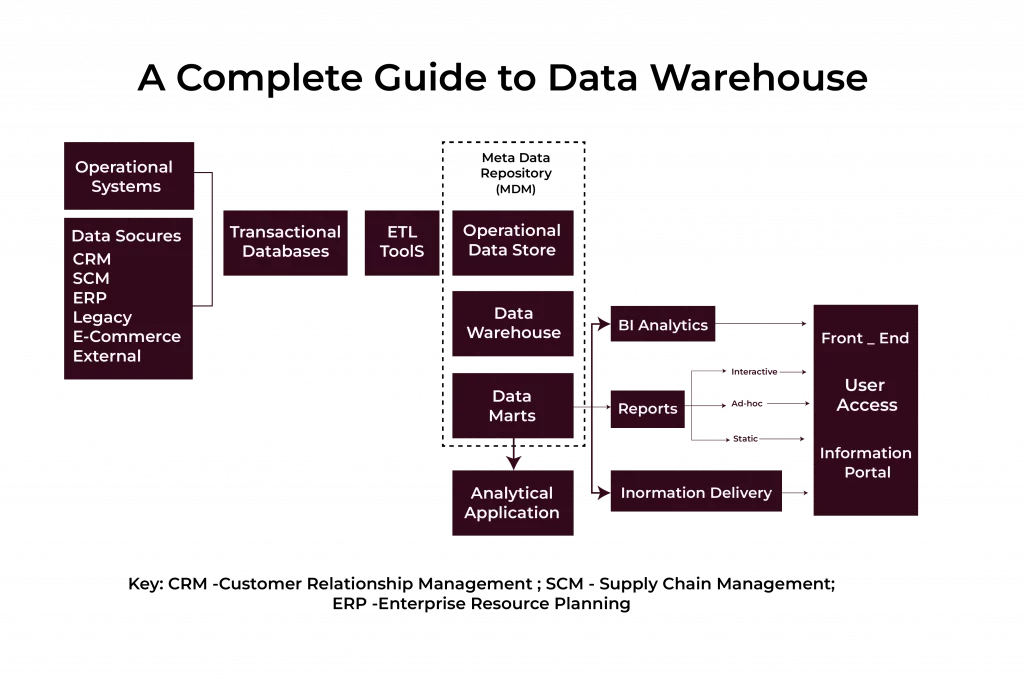Data has been acclaimed as new oil. However, as with oil, it must be refined before it becomes useful.
Organisations create a mass of data from sales transactions, customer feedback, marketing campaigns, operational systems, and other sources on a daily basis. However, this source data is usually untidy, disorganised, and not easily transformed into insightful information.
A data warehouse is a specialised system that allows the concentration of loads of data coming from different sources into one central location. It integrates, cleans, and organises data in preparation for analysis and reporting. Data warehouses are different from traditional databases because they are optimised for analytical queries and long-term historical data storage rather than managing day-to-day transactions.
For example, a retail organisation can analyse the buying behaviour of its customers over time, while a healthcare institution can track the outcomes of treatment for various patient populations.
In this blog, we will delve into the characteristics of data warehouse, its architecture, functions, and real-world applications. Engage with the content to understand why this resource has emerged as indispensable to organisations seeking to stay abreast with their dynamic environment.

Three-Tier Architecture for a Data Warehouse System
Analysis of the data is not carried out by simply dumping them in one place. A data warehouse follows a three-tier architecture to ensure smooth operations. Each layer has a specific function, which enhances the overall efficiency of the system.
Bottom Tier: Data Sources and Backend Data Integration
The bottom tier forms the foundation of a data warehouse.
It connects to all the source systems where raw data resides. These sources include transactional databases, spreadsheets, and external systems.
Data is extracted, cleaned, and transformed using ETL (Extract, Transform, Load) tools.
Here’s what this tier does:
- Cleans the data by fixing errors or inconsistencies.
- Converts data into a uniform format for easy analysis.
- Stores the transformed data in a structured format for retrieval.
For example, a retail company might pull sales data from its billing systems and customer information from a CRM tool.
The bottom tier ensures this data is ready for analysis.
Also Read: Three-Tier Architecture of Data Warehouse
Middle Tier: Analytical Engines and OLAP Systems
This layer contains analytical processing systems like OLAP (Online Analytical Processing) tools.
OLAP tools enable users to perform:
- Multi-dimensional analysis (e.g., sales by region, product, and time).
- Drill-down operations to dive deeper into specifics.
For example, an e-commerce platform could analyse customer buying trends during festivals by region and product category.
The middle tier makes these insights possible without the need for raw data handling.
Top Tier: User Interfaces for Reports, Dashboards, and Visualisations
The top tier is the user-facing layer. It includes dashboards, reports, and visualisation tools that display data insights.
Users don’t need to know how the data is processed—they just see the results.
For example, a manager at a manufacturing firm might use a dashboard showing inventory levels across multiple warehouses.
These visual tools make data easy to understand and actionable.


POSTGRADUATE PROGRAM IN
Data Science & AIML
Learn Data Science, AI & ML to turn raw data into powerful, predictive insights.
Functional Capabilities of a Data Warehouse in Business Intelligence
Businesses need to deal with lots of data. But data by itself is useless.
A data warehouse helps in preserving and structuring information to be used when making a decision.
Let’s see how a data warehouse seems to bring order out of chaos.
Data Consolidation to Break Down Silos
An organisation usually collects data from a source, and that rarely tends to be in the same format. This would thus form silos where different departments do not share the same insights.
A data warehouse aggregates information from disparate systems, such as CRM tools, ERP platforms, and transactional databases, into a single repository.
For instance, a retail enterprise may amalgamate customer purchase data derived from both physical stores and online platforms.
All data gets collected from one place, making a better understanding of business performance.
Data Cleaning and Transformation for Accuracy and Consistency
The data will be very dirty. Raw data is likely to hold redundancy, missing values, or inaccuracies that make it hard to analyse. Data warehouses correct and transform this raw data during the ETL extract, transform and load procedure.
For example:
- Date formats, for example, MM/DD/YYYY instead of DD/MM/YYYY.
- Removing duplicate records.
- Imputation of missing values using inferred approximations.
Clean data leads to better decisions because you’re working with accurate and reliable information.
Centralised Data Storage for Easy Retrieval and Access
A centralised storage system is, in fact, one of the fundamental elements of a data warehouse. It ensures that all historical and current data are systematically stored, thus ensuring ease of access.
Rather than sifting through individual spreadsheets or systems, one can access all information in a single location.
It saves time and reduces errors caused by the use of outdated information.
Also Read: Exploring Advantages and Disadvantages of Data Warehouse
Advanced Data Analysis for Strategic Insights
A data warehouse makes it easier to deploy powerful analytical tools like OLAP (Online Analytical Processing). Such tools enable users to drill down to details, pivot and re-arrange data or put them together for a sense of perspective.
For instance, a finance team may analyse by revenue trends by region, month or product categories- all of this with one click.
Such analysis helps businesses to identify new opportunities for growth and problematic areas.
Extracting Hidden Patterns and Trends through Data Mining
Data mining is like discovering golden insights in a mountain of information. It is the process of using algorithms to find patterns, trends, or correlations that are not obvious.
A supermarket chain could find that customers buying bread also often purchase butter.
This insight can drive promotions, like bundling bread and butter at a discount, to boost sales.
Generating Reports for Effective Decision-Making
Reports are an important part of any data warehouse. Reports articulate the data in an easily understandable manner, often via graphs or charts, making the data very easy to implement.
For instance, a sales manager might get a report showing daily revenue and compare it with the monthly goals.
These reports boil down the statistics to practical steps.
The Core Characteristics of Data Warehouse
The characteristics of data warehouse make it indispensable for businesses across industries.
From organising data by subjects to enabling time-based analysis and mining valuable insights, every feature is built to support smarter decisions. These characteristics of data warehouse show how it transforms raw data into valuable insights.

Subject-Oriented Organisation for Focused Analysis
A data warehouse doesn’t mix all kinds of data together. It organises data by specific topics or subjects. These subjects could include sales, inventory, or customer demographics.
Imagine you manage an online bookstore. Instead of sifting through endless operational details, you can look at sales-specific data. For instance, “What genres sold best last quarter?” or “Which customer segment spent the most?”
By focusing on specific subjects, we can make faster, more effective decisions.
Also Read: Top 20 Most Used Data Warehouse Tools
Data Integration Across Multiple Sources
Data doesn’t come from one place. It might live in transactional systems, flat files, or even spreadsheets. The characteristics of data warehouse is to integrate all this data into a single system, ensuring consistency and uniformity.
For example:
- Customer details from CRM systems.
- Product inventories from ERP tools.
- Marketing performance from analytics platforms.
The process that makes this integration possible is called ETL:
- Extract the data from various sources.
- Transform it into a standardised format.
- Load it into the warehouse for analysis.
Integration ensures that your data warehouse provides a single source of truth.
Time-Variant Data for Long-Term Insights
Time is an essential factor in storing data in a warehouse. This allows businesses to analyse trends over time.
For example:
- A healthcare provider can track patient outcomes for treatments over the past five years.
- A retail chain can compare seasonal sales data across decades.
By storing data with timestamps, we can answer questions like “How has our customer churn rate changed over the last three years?”
This time-stamped approach makes forecasting more accurate.
Non-Volatile Data Storage for Reliability
Once data enters the warehouse, it doesn’t change. These non-volatile characteristics of data warehouses ensure historical accuracy.
Imagine you’re running a financial institution. When auditing records, you need to know that past data hasn’t been tampered with.
In a data warehouse, information is read-only. New data is added without altering the existing information. This is why historical insights remain reliable and trustworthy.
Scalability for Massive Data Handling
Data keeps growing, and so do the demands of analysis. A good data warehouse is scalable. It handles terabytes or even petabytes of data without performance issues.
Take e-commerce companies in India, such as Flipkart. Their warehouses manage billions of transactions every year. They rely on a scalable architecture to ensure smooth performance, even during massive sales like Big Billion Days.
The scalability characteristics of data warehouses ensure that the warehouse grows with the organisation’s needs.
Read-Optimised Design for Quick Analysis
A data warehouse is designed for fast queries and reporting. Unlike transactional systems that are built for frequent updates, warehouses focus on analysis.
For example:
- Comparing revenue across different regions.
- Tracking product returns over multiple months.
Since warehouses are read-optimised, they return results quickly, enabling timely decisions.
Schema-on-Write for Consistent Data Organisation
A data warehouse uses a schema-on-write model. This means that data is structured according to a predefined format before it’s stored.
For instance:
- A sales table in a warehouse might always have columns for date, product, quantity, and amount.
- Every record follows this schema, ensuring consistency.
This characteristics of data warehouse makes data retrieval faster and analysis simpler.
Query-Driven Systems for Flexible Decision-Making
Not all decisions require the same type of data. That’s why data warehouses support ad-hoc queries. We can ask specific questions and get instant answers.
For example:
- “What were the top-selling products in the North region last quarter?”
- “Which marketing campaigns drove the most revenue last year?”
This characteristics of data warehouse ensures that decision-makers don’t need to wait for IT teams to generate reports.
Also Read: Top 30 Data Warehouse Interview Questions & Answers
Real-World Applications and Use Cases of Data Warehousing
Data warehouses aren’t just about storing data. They’re the backbone of industries looking to make informed, strategic decisions.
Here are some examples of how they’re used across sectors.
| Industry | Applications of Data Warehousing | Examples |
| Retail | Optimising sales, inventory, and marketing strategies. | – Analysing product sales trends by region. |
| – Adjusting stock levels to avoid overstocking or shortages. | ||
| – Identifying loyal customers for targeted campaigns. | ||
| Example: Big Bazaar predicts demand during festive seasons and stocks shelves accordingly. | ||
| Healthcare | Enhancing patient care and treatment analysis. | – Analysing recovery rates for specific treatments. |
| – Tracking the spread of diseases over time. | ||
| Example: Government health initiatives in India planning vaccination drives using data insights. | ||
| Finance | Detecting fraud and forecasting market trends. | – Monitoring transactions for unusual activities like sudden large withdrawals. |
| – Analysing stock performance over decades to predict trends. | ||
| Example: SBI uses data to enhance customer security and improve investment strategies. | ||
| Manufacturing | Improving inventory management and supply chain efficiency. | – Tracking raw material usage to prevent shortages. |
| – Analysing supplier performance to reduce delays. | ||
| Example: Tata Motors tracks component availability across factories to ensure smooth production. |

82.9%
of professionals don't believe their degree can help them get ahead at work.
Benefits and Challenges of Implementing a Data Warehouse
Key Benefits of Data Warehousing: Efficiency, Decision-Making, and Scalability
Data warehouses offer multiple benefits:
Improved Decision-Making:
By providing a unified source of information, data warehouses enable businesses to make data-driven decisions.
Faster Data Retrieval:
Queries run faster because the data is pre-processed and structured.
Scalability:
They can handle growing data volumes, ensuring smooth operations even as businesses expand.
Historical Insights:
Data warehouses store years of data, making trend analysis and forecasting possible.
Addressing Common Challenges: Integration, Maintenance, and Costs
While data warehouses are powerful, implementing them comes with challenges.
Integration Issues:
Bringing data from multiple sources into a consistent format is complex.
High Costs:
Setting up and maintaining a data warehouse requires significant investment.
Maintenance:
Ensuring data accuracy and performance optimisation is an ongoing task.
Also Read: Understanding Data Warehouse Concepts
Conclusion
A data warehouse is way more than a mere data storage system.
The three-tier architecture simplifies complex processes and supports tools for in-depth analysis and reporting.
Its structured approach- from integration and consolidation of data to the support of advanced analytics ensures that businesses get all the insights required for decision-making. Features such as subject-oriented organisation, time-variant data, and non-volatile storage give it the reliability and durability of insight.
From addressing integration challenges to handling massive data volumes with ease, the characteristics of data warehouse make it an essential tool in today’s fast-paced world.
Organisations across industries rely on it to make smarter, faster, and more strategic decisions.
For someone who wants to learn advanced technologies like data warehousing, Hero Vired’s Certificate Program in DevOps and Cloud Engineering is the next best step up. Participants learn the material from industry experts as well as develop cutting-edge tool proficiency, ensuring an accelerated career pathway in cloud computing and data engineering.
Can data warehouses accommodate real-time data?
Which industries use data warehousing the most?
Which tools are commonly used in a data warehouse?
Updated on January 22, 2025
